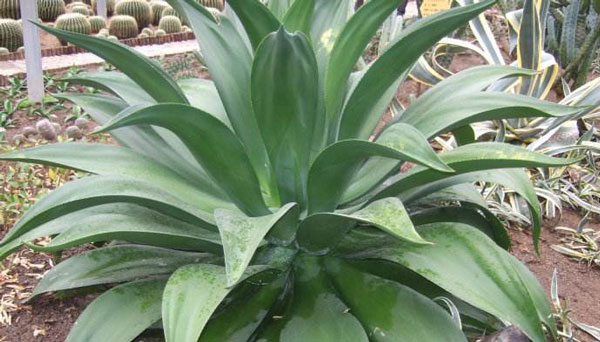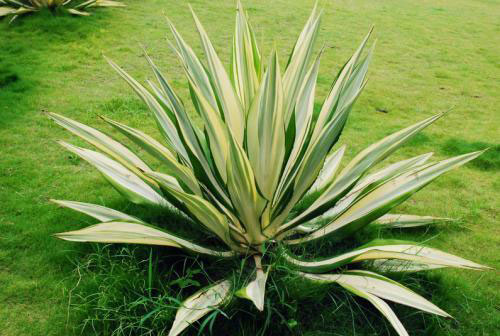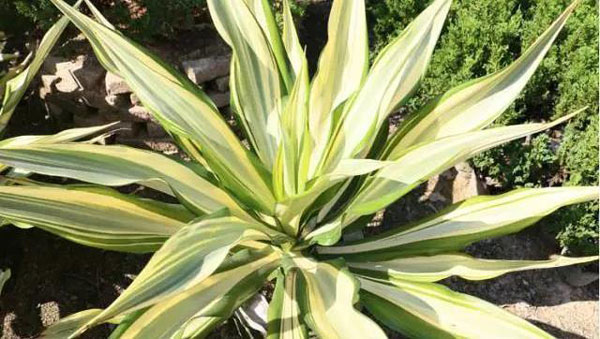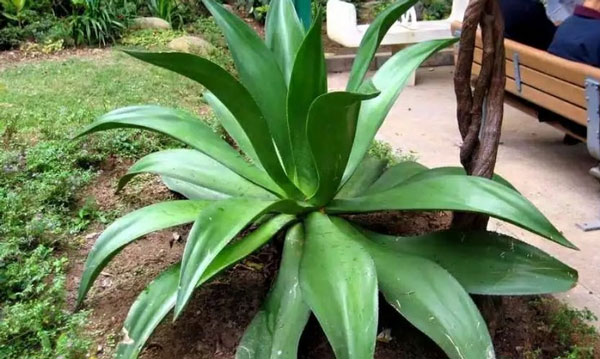Foxtail Agave (Agave Attenuata) Care & Growing Guide
Written by Iris
Nov 12 2021

Agave Attenuata is a large evergreen succulent that is commonly known as Fox Tail Agave, Swan's Neck Agave, Lion's Tail Agave, Dragon Tree Agave, or Century Plant. The flower of Foxtail agave (Agave attenuata) is actually a raceme, which appears in the summertime, growing high above the foliage of the plant to a height of up to ten feet.

Read More:
12 Popular Evergreen Plants with Pictures for Beginners
If your Agave attenuata has sprouted one or more suckers and you wish to repot them to make new plants, carefully pull the sucker away from the parent plant. Then, give them a little time to dry out, which will reduce the risk of your new plants acquiring root rot and oftentimes resulting in early death. Once they've dried out, repot them in a container or elsewhere in your garden, and be sure to offer your new baby plant plenty of water and sunlight during the growing stages.
You can cut the pup at a slanted angle away from the larger plant. When cutting, take care to leave a bit of the stem that attached the pup to the parent plant, which will provide a healthy area for the new roots to form.
Once your pup is separated, allow the cut part to air dry until a hard callus form over the area, and once that end is hardened (which could take anywhere from several days to a few weeks), place it in a container of soil deep enough that the pup is supported and won't fall over.
If you have kept the plant in partial shade and wish to move it to a full sun position, then you should do so gradually, increasing the hours of direct sun it gets over the course of a few weeks. If suddenly moved into a different lighting position, the Foxtail agave plant could go into shock and lose its leaves.
If you are concerned about over-watering the plant, then you can wait for it to show signs of dryness before watering it. As well as checking the soil, you can also check the foliage of the plant for this, as its leaves will shrink and shrivel when it is short on moisture.
If you notice this happening with your Foxtail agave, you should give it a liberal watering. If the Foxtail agave plant has sufficient water, its leaves will appear to be juicy and plump. If you do happen to over-water the foxtail agave, then you shouldn't worry too much, as this plant is actually well equipped to deal with over-watering, and won't easily succumb to root rot like many other succulents.
That being said, the Foxtail agave does have low water needs, so don't make a habit of giving it too much water. The best way to water this plant is at the soil level, as it doesn't like moisture sitting on its foliage.
Agave attenuata ‘Variegata’
This variety of foxtail agave is commonly known as lion’s mane agave, and it’s easy to understand why upon viewing the plant. Its pale green leaves feature vertical stripes of yellow, which give the impression of a lion’s mane when the leaves are packed into a rosette shape. This plant has similar care requirements to the fox tail agave but is less likely to enjoy partial shade. To maintain the variegated pattern, it is best to keep this plant in a position of full sun.
Agave attenuata ‘Nova’
This Foxtail agave goes by several other names, including ‘Boutin Blue.’ It has wide blue-green foliage and is slightly more tolerant of cool weather than its relatives. It is hardy through USDA hardiness zones 8 to 12.
Agave attenuate 'Ray of Light’
This agave has variegated leaves, which are gray-green in the center, and then fade out to a paler green before merging into creamy yellow on the leaf margins. Foliage develops from a chunky central stem, which typically grows to 4 or 5 feet in height.
Juice of leaf and even outer layers of the leaf are highly irritant to skin. Foxtail agave (Agave attenuata) is not likely fatal but can burn and injure you or your pet's mouth and throat.

How to Grow Foxtail agave (Agave attenuata)Foxtail agave Propagation with SeedsFoxtail agave Propagation with CuttingsFoxtail agave Propagation with PupsHow to Care for Foxtail agave (Agave Attenuata)Agave Attenuata Light CareAgave Attenuata Soil CareAgave Attenuata WateringAgave Attenuata Temperature & Humidity CareAgave Attenuata Fertilizer CareAgave Attenuata Pruning CareAgave Attenuata Pests & Diseases CareVarieties of Foxtail agave (Agave attenuata)Foxtail agave (Agave attenuata) FAQIs Foxtail agave Toxic?Can Foxtail agave be grown as an indoor plant in colder climates?How Big Does Foxtail agave Grow?Does The Foxtail agave Flower?
How to Grow Foxtail agave (Agave attenuata)
Foxtail agave Propagation with Seeds
Start foxtail agave (Agave attenuata) seeds in a 50/50 mix of commercial soil and sifted crushed granite. Cover the Foxtail agave seeds in a small plastic pot with a small measure of the soil mixture. Usually this is about the diameter of the seed. They should not be placed very deep into the soil. They should be just below the surface. Set the pot in a pan of distilled water and leave there until you see that the soil is wet. Remove the pot and then allow to drain for several minutes. Cover the pot with a plastic bag and secure with a rubber band. Set the seedling on a windowsill where it will receive diffused light instead of direct sunlight. The seedling will begin to sprout after about 4 weeks.Read More:
12 Popular Evergreen Plants with Pictures for Beginners
Foxtail agave Propagation with Cuttings
Luckily, some plants have mechanisms in place to help propagate themselves, the agave attenuata being one of them. This Foxtail agave (Agave attenuata) naturally grow long protrusions known as "suckers" from near their own base, which grows upward and outward, resembling an elephant's trunk (which is why they're sometimes referred to as the elephant trunk plant).If your Agave attenuata has sprouted one or more suckers and you wish to repot them to make new plants, carefully pull the sucker away from the parent plant. Then, give them a little time to dry out, which will reduce the risk of your new plants acquiring root rot and oftentimes resulting in early death. Once they've dried out, repot them in a container or elsewhere in your garden, and be sure to offer your new baby plant plenty of water and sunlight during the growing stages.
Foxtail agave Propagation with Pups
One way to propagate Foxtail agave (Agave attenuata) is by separating pup plants from the mother. These pups appear around mature Agave plants and appear as smaller versions of the same plant, usually found near the base of a large stem.You can cut the pup at a slanted angle away from the larger plant. When cutting, take care to leave a bit of the stem that attached the pup to the parent plant, which will provide a healthy area for the new roots to form.
Once your pup is separated, allow the cut part to air dry until a hard callus form over the area, and once that end is hardened (which could take anywhere from several days to a few weeks), place it in a container of soil deep enough that the pup is supported and won't fall over.

How to Care for Foxtail agave (Agave Attenuata)
Agave Attenuata Light Care
The Foxtail agave is a full sun plant and thrives in these conditions. Foxtail agave can acclimate to partial shade, especially if the shade is during the afternoon, as the Foxtail agave plant can struggle with excessive heat and might appreciate some respite during the hottest part of the day.If you have kept the plant in partial shade and wish to move it to a full sun position, then you should do so gradually, increasing the hours of direct sun it gets over the course of a few weeks. If suddenly moved into a different lighting position, the Foxtail agave plant could go into shock and lose its leaves.
Agave Attenuata Soil Care
When the soil is sufficiently drained the Foxtail agave (Agave attenuata) would grow very well and when in pots a good succulent and cacti mix and when in the ground a proportionate 70% parent soil to 30% succulent and cacti mix would be ideal.Agave Attenuata Watering
Like many succulents, the Foxtail agave is drought tolerant and can withstand long periods without moisture. However, it will be at its best when it receives regular water. The amount of light your plant gets and the temperature it is in will have a large impact on how often it needs to be watered. Mature fox tail agaves in a full sun position during the summer should be watered generously around once each week. This would need to become much less frequent during the winter months when in most regions, the Foxtail agave plant would be able to survive on rainwater alone.If you are concerned about over-watering the plant, then you can wait for it to show signs of dryness before watering it. As well as checking the soil, you can also check the foliage of the plant for this, as its leaves will shrink and shrivel when it is short on moisture.
If you notice this happening with your Foxtail agave, you should give it a liberal watering. If the Foxtail agave plant has sufficient water, its leaves will appear to be juicy and plump. If you do happen to over-water the foxtail agave, then you shouldn't worry too much, as this plant is actually well equipped to deal with over-watering, and won't easily succumb to root rot like many other succulents.
That being said, the Foxtail agave does have low water needs, so don't make a habit of giving it too much water. The best way to water this plant is at the soil level, as it doesn't like moisture sitting on its foliage.
Agave Attenuata Temperature & Humidity Care
Agave attenuata loves heat, is sensitive to frost, at temperatures below -2 ° C can be seriously affected.Agave Attenuata Fertilizer Care
The Foxtail agave (Agave attenuata) does not rely on regular feedings to thrive, and in fact, can live happily for many years with just the nutrients contained in its soil. If you do want to fertilize the plant, use a diluted liquid fertilizer during the summer months, and refrain from fertilizing at all during winter. Be careful not to apply fertilizer too frequently as this can cause more harm than good in this plant. One thing you can do to ensure your Foxtail agave receives the necessary nutrients is to refresh its soil every few years. Nutrients in the soil can become depleted over time, so refreshing the soil by adding a top layer of organic compost, or repotting your Foxtail agave plant with completely new soil, will be more than enough to keep your foxtail agave from becoming nutrient deficient.Agave Attenuata Pruning Care
Foxtail agave requires little pruning beyond removing old or damaged leaves and trimming back the dead shoot after flowering has finished.Agave Attenuata Pests & Diseases Care
When grown outdoors agave is susceptible to plant-eating insects such as the Agave snout weevil, soft scape, and the cactus longhorn beetle. Signs of infestation include withering or dry leaves and brown spots. Treat infested plants with a broad spectrum insecticide or diluted neem oil for a natural alternative. Agave can also fall victim to bacterial and fungal infections, including leaf spot and crown and root rot. Treat agaves with an antifungal agent occasionally to prevent infection. Destroy affected plants to prevent the spread of the disease.
Varieties of Foxtail agave (Agave attenuata)
Some other varieties of the foxtail agave include the following.Agave attenuata ‘Variegata’
This variety of foxtail agave is commonly known as lion’s mane agave, and it’s easy to understand why upon viewing the plant. Its pale green leaves feature vertical stripes of yellow, which give the impression of a lion’s mane when the leaves are packed into a rosette shape. This plant has similar care requirements to the fox tail agave but is less likely to enjoy partial shade. To maintain the variegated pattern, it is best to keep this plant in a position of full sun.
Agave attenuata ‘Nova’
This Foxtail agave goes by several other names, including ‘Boutin Blue.’ It has wide blue-green foliage and is slightly more tolerant of cool weather than its relatives. It is hardy through USDA hardiness zones 8 to 12.
Agave attenuate 'Ray of Light’
This agave has variegated leaves, which are gray-green in the center, and then fade out to a paler green before merging into creamy yellow on the leaf margins. Foliage develops from a chunky central stem, which typically grows to 4 or 5 feet in height.

Foxtail agave (Agave attenuata) FAQ
Is Foxtail agave Toxic?
Foxtail agave (Agave attenuata) contains a poisonous sap that can lead to severe skin irritation and digestive problems.Juice of leaf and even outer layers of the leaf are highly irritant to skin. Foxtail agave (Agave attenuata) is not likely fatal but can burn and injure you or your pet's mouth and throat.
Can Foxtail agave be grown as an indoor plant in colder climates?
Foxtail agave (Agave attenuata) can be grown indoors as long as it is placed in a sunny window where it can receive the light and warmth it needs. It is a particularly good choice because it does not have thorns, but indoor gardeners should make sure that it has room to grow. Gardeners can also move a Foxtail agave (Agave attenuata) planted in a container indoors during the winter.How Big Does Foxtail agave Grow?
The yellowish green leaves grow in a handsome rosette near the base, ranging from 20” to 28” inches in length and 5” to 6” inches in width. As the leaves die off, the stems remain visible. These stems can reach heights of 60” inches. However, the inflorescence can reach up to ten feet. The arching flower stalk curves back towards the ground and sometimes feature a second arch, resembling a foxtail. The Foxtail agave (Agave attenuata) produces many “suckers” or offshoots. These Foxtail agave offshoots increase the clumping of the foliage, resulting in thicker growth.Does The Foxtail agave Flower?
When the inflorescence blooms, the flower stalk features small, greenish-yellow petals. These flowers eventually fall and are replaced by seed pods, making agave propagation easy.Latest Updated
- Benefits of Bugleweed - 7 Science-backed Health Benefits
- Bugleweed Dangers & Side Effects - Is It Poisonous?
- How to Plant Evergreen Trees - What You Should Know
- When to Plant Evergreens - Grow Guide for Evergreen Trees
- 12 Wonderful Evergreen Shrubs for Your Garden
- 12 Popular Evergreen Plants with Pictures for Beginners
- When And How To Prune A Lilac Bush Like a Pro
- How to Grow & Care for Lilac Vine (Hardenbergia Violacea)
- Japanese Lilac Tree (Syringa Reticulata) Care & Propagation Guide
- Shumard Oak Pros and Cons - What to Know
Popular Articles
- Winter maintenance of Antirrhinum Majus
- How to Grow Terminalia Mantaly Tree
- How to Grow and Care for Crossostephium Chinense
- How to grow Antirrhinum Majus in spring
- Peristeria Elata (Dove Orchid) Profile: Info & Care Guide
- Underwatered Snake Plant (Sansevieria Trifasciata) - Signs And How To Fix
- How to Care for Brazilian Jasmine Plant (Mandevilla Sanderi)
- How to Grow & Care for Graptopetalum Purple Delight in Summer
- Rosa Chinensis (China Rose): Plant Growing & Care Tips
- How to Care for Baby Sun Rose (Aptenia Cordifolia)